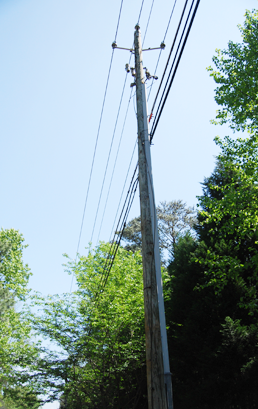Joint Use Trivia: Everything You Never Knew About Utility Poles
 We discuss utility pole assets often on the Alden Updater. You see them every day while you’re driving, walking, and just going about your business. If you are reading this blog, you may already know a lot about them. So, what are these mysterious objects of our attention, perhaps affection or possibily disdain? Utility poles...no matter how much you think you may know, there is always more to discover.
We discuss utility pole assets often on the Alden Updater. You see them every day while you’re driving, walking, and just going about your business. If you are reading this blog, you may already know a lot about them. So, what are these mysterious objects of our attention, perhaps affection or possibily disdain? Utility poles...no matter how much you think you may know, there is always more to discover.
Here, we present ten fun facts about our favorite 40-foot assets.
- Utility poles are mostly made of Southern Yellow Pine. While Pinus palustris, commonly grown in a wide swath of land between Virginia and Texas[1], is the most popular choice for a utility pole, many other species of naturally long, straight trees are also used. Among them: Douglas Fir, Jack Pine, Lodgepole Pine, Western Red Cedar and Pacific Silver Fir.[2]
- A pole by a different name is mostly the same. We may refer to them as “utility poles” here, but ask around the world, and they are known by a number of other names: electric poles, distribution poles, telephone poles, telecommunication poles, power poles, hydro poles, telegraph poles, and power posts, to name a few.[3]
- There are a lot of utility poles out there. In fact, there are an estimated 180 million of them standing tall around the U.S. This means there are roughly 1.76 people for every utility pole in the United States.[4]
- Some utility poles are really, really tall. Typical poles are 40 to 60 feet tall, but the world’s tallest power line suspension towers reside in Jiangyin, China. These behemoths are 1,137 feet tall each.[5]
- Other utility poles are relatively tiny. The small town of Woodseaves, Staffordshire, England lays claim to the world’s smallest telegraph pole. It resides on the second tier of a bridge, and despite its diminutive size, boasts six cross pieces.[6]
- Utility poles have been around for a long time. The first telephone pole was built in 1876 as part of a telephone installation for a friend of Alexander Graham Bell's employer.[7]
- Some poles are fairly old themselves. One can expect a typical wooden utility pole to last between 40 and 60 years, and many in the field are 50 to 60 years of age already.
- Parts of old utility poles can be valuable. While U.S. utility companies transitioned to using porcelain insulators in the 1970s, the previously popular glass models have become collectable, and in some cases, valuable. Most are clear or aqua, but other colors can be found as well, including amber, blue, and dark garnet red, the rarest color of all. [8]
- The most unique pole anywhere may just be in Florida. Look up along Interstate 4 outside Kissimmee, Florida, near the westernmost exit for the Walt Disney World resort and you will see Mickey Mouse in the lines. A unique tower found here features three hoops that form the shape of the cartoon rodent’s head and ears, with each hoop suspending wires.
- South of the Mason-Dixon line, exotic animals are not welcome near poles. For some reason, it is against the law in the southern capital of Atlanta to hitch a giraffe to a utility pole or street lamp. We will try to remember that, as should you.[9]
[1] http://en.wikipedia.org/wiki/Pinus_palustris
[2] http://www.funtrivia.com/askft/Question117310.html
[3] http://en.wikipedia.org/wiki/Utility_pole#cite_note-1
[4] http://www.elp.com/articles/powergrid_international/print/volume-16/issue-10/features/preservative-choices-for-wood-utility-poles.html
[5] http://en.wikipedia.org/wiki/Yangtze_River_power_line_crossings
[6] http://staffordshiredailyphoto.blogspot.com/2013/09/smallest-telegraph-pole.html
[7] http://isostainless.com/stainless-steel-blog/interesting-facts-about-telephone-and-telegraph-poles
[8] http://railrunner42.tripod.com/myglassinsulatorsite/id12.html
[9] http://www.dumblaws.com/laws/united-states/georgia?page=20
